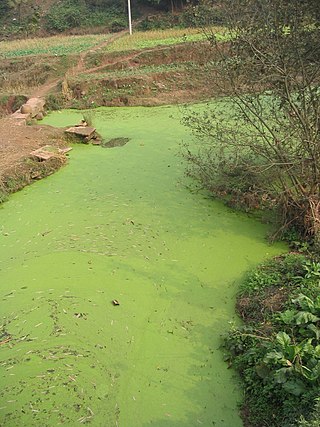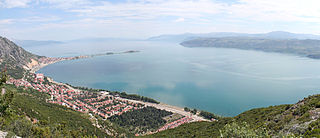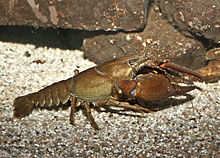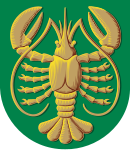
Mälaren, historically referred to as Lake Malar in English, is the third-largest freshwater lake in Sweden. Its area is 1,140 km2 and its greatest depth is 64 m. Mälaren spans 120 kilometers from east to west. The lake drains, from south-west to north-east, into the Baltic Sea through its natural outlets Norrström and Söderström and through the artificial Södertälje Canal and Hammarbyleden waterway. The easternmost bay of Mälaren, in central Stockholm, is called Riddarfjärden. The lake is located in Svealand and bounded by the provinces of Uppland, Södermanland and Västmanland. The two largest islands in Mälaren are Selaön (91 km2) and Svartsjölandet (79 km2). Mälaren is low-lying and mostly relatively shallow.

Crayfish are freshwater crustaceans belonging to the infraorder Astacidea, which also contains lobsters. Taxonomically, they are members of the superfamilies Astacoidea and Parastacoidea. They breathe through feather-like gills. Some species are found in brooks and streams, where fresh water is running, while others thrive in swamps, ditches, and paddy fields. Most crayfish cannot tolerate polluted water, although some species, such as Procambarus clarkii, are hardier. Crayfish feed on animals and plants, either living or decomposing, and detritus.

Eutrophication is a general term describing a process in which nutrients accumulate in a body of water, resulting in an increased growth of microorganisms that may deplete the water of oxygen. Although eutrophication is a natural process, manmade or cultural eutrophication is far more common and is a rapid process caused by a variety of polluting inputs including poorly treated sewage, industrial wastewater, and fertilizer runoff. Such nutrient pollution usually causes algal blooms and bacterial growth, resulting in the depletion of dissolved oxygen in water and causing substantial environmental degradation.

A wetland is a distinct ecosystem that is flooded or saturated by water, either permanently for years or decades or seasonally for a shorter periods. Flooding results in oxygen-free anoxic processes prevailing, especially in the soils. The primary factor that distinguishes wetlands from terrestrial land forms or water bodies is the characteristic vegetation of aquatic plants, adapted to the unique anoxic hydric soils. Wetlands are considered among the most biologically diverse of all ecosystems, serving as home to a wide range of plant and animal species. Methods for assessing wetland functions, wetland ecological health, and general wetland condition have been developed for many regions of the world. These methods have contributed to wetland conservation partly by raising public awareness of the functions some wetlands provide. Constructed wetlands are designed and built to treat municipal and industrial wastewater as well as to divert stormwater runoff. Constructed wetlands may also play a role in water-sensitive urban design.

Astacus is a genus of crayfish found in Europe, comprising three extant (living) species and three extinct fossil species.
Crayfish plague is a water mold that infects crayfish, most notably the European Astacus which dies within a few weeks of being infected. When experimentally tested, species from Australia, New Guinea and Japan were also found to be susceptible to the infection.

The signal crayfish is a North American species of crayfish. It was introduced to Europe in the 1960s to supplement the North European Astacus astacus fisheries, which were being damaged by crayfish plague, but the imports turned out to be a carrier of that disease. The signal crayfish is now considered an invasive species across Europe, Japan, and California, ousting native species there.

Pontastacus leptodactylus, the Danube crayfish, Galician crayfish, Turkish crayfish or narrow-clawed crayfish, is a relatively large and economically important species of crayfish native to fresh and brackish waters in eastern Europe and western Asia, mainly in the Pontic–Caspian region, among others including the basins of the Black Sea, and the Danube, Dnieper, Don and Volga rivers, as well as aquatic systems in Turkey. It has spread widely beyond its native range, beginning in the 1700s when it spread via canals constructed in western Russia and since the 1900s through introducions to many regions for human consumption. Today it is widespread throughout much of Europe.

Eğirdir is a lake in the Lakes Region of Turkey. The town of Eğirdir lies near its southern end, 107 kilometers north of Antalya. With an area of 482 square kilometres (186 sq mi) it is the fourth largest lake in Turkey, and the second largest freshwater lake.

The Murray crayfish, Euastacus armatus, is a species of freshwater crayfish endemic to Australia that belongs to the family Parastacidae. The Murray crayfish has the largest geographic range of any of the Euastacus crayfish in Australia, being found in the Murray and Murrumbidgee Rivers as well as many of their tributaries. Murray crayfish are also known as "Murray River crayfish", "Murray crays", "freshwater crays", "spiny freshwater crays", "spinies" and in the Wagga Wagga region of southern New South Wales they are simply known as "lobsters".

Procambarus clarkii, known variously as the red swamp crayfish, Louisiana crawfish or mudbug, is a species of cambarid crayfish native to freshwater bodies of northern Mexico, and southern and southeastern United States, but also introduced elsewhere, where it is often an invasive pest.
Cherax quinquecarinatus is a small freshwater crayfish endemic to the south-west corner of Australia. It is one of two species known as gilgie, or jilgi, which is a seasonal food source for people of the region. Gilgies are found throughout a biogeographically isolated region of the coastal south of Western Australia and are significant in the ecology of aquatic systems of that bioregion.
Fluvidona anodonta or more commonly known as the North Pine River freshwater snail is a species of minute freshwater snail that is endemic to Australia. Originally discovered in 1892 by Hedley & Musson, the snail is highly elusive and only has been sighted four times since its discovery. The snail is 2 mm long and 1 mm wide with the shell colouring being of a yellow-whiteish shade. Fluvidona anodonta resides within the City of Moreton Bay, specifically in four river systems within the D'Aguilar National Park, Queensland. The four river systems are the South Pine River headwaters, the North Pine River headwaters, Kobble Creek and Low Branch Creek. The snail is found under deeply submerged rocks within permanent freshwater systems.

Astacoides is a genus of freshwater crayfish endemic to Madagascar. The first specimens were brought to Europe in 1839, and seven species are now recognised, most of which are considered as threatened on the IUCN Red List. They are large and slow-growing, and are threatened by habitat loss, overexploitation by local people and by spread of introduced non-indigenous marbled crayfish. They are only found in a relatively small part of the island, mostly in undisturbed upland areas. They belong to the Gondwana-distributed family Parastacidae, but their nearest relatives live in Australasia, there being no native crayfish in mainland Africa or India.

Austropotamobius torrentium, also called the stone crayfish, is a European species of freshwater crayfish in the family Astacidae. It is mostly found in tributaries of the Danube, having originated in the northern part of the Balkan Peninsula.

Faxonius limosus, synonym Orconectes limosus, is a species of crayfish in the family Cambaridae. It is native to the east coast of North America, from Quebec to the lower James River, Virginia, but has also been introduced to Europe. It is known commonly as the spinycheek crayfish or Kamberkrebs in German.

A wild fishery is a natural body of water with a sizeable free-ranging fish or other aquatic animal population that can be harvested for its commercial value. Wild fisheries can be marine (saltwater) or lacustrine/riverine (freshwater), and rely heavily on the carrying capacity of the local aquatic ecosystem.

Faxonius virilis is a species of crayfish known as the virile crayfish, northern crayfish,eastern crayfish, and lesser known as the lake crayfish or common crawfish. Faxonius virilis was reclassified in August 2017, and the genus was changed from Orconectes to Faxonius. It is native to the central United States, east to tributaries of Lake Erie, Lake Ontario, Lake Champlain and the St. Lawrence River in New York and to much of Canada.
Saltwater fish, also called marine fish or sea fish, are fish that live in seawater. Saltwater fish can swim and live alone or in a large group called a school.

Austropotamobius bihariensis is a species of crayfish in the family Astacidae. It is known to exist only in Romania being restricted to the rivers in the western Apuseni Mountains. Its proposed English common name is idle crayfish. It is supposed to have diverged/split ~15 Ma old from a common relative of A. torrentium from the Dinarides and evolved isolated due to the historically tectonic north-eastern movement of Tisza-Dacia mega-unit through the Pannonian Basin, during the Miocene. The molecular divergence in 582 base length nucleotides of COI mtDNA sequences is supported by 43 mutational steps, a differentiation of 7.4% from the sister clade of A. torrentium located in north-western Dinarides



















